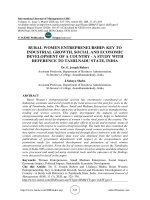Economic growth and economic development 87
Bạn đang xem bản rút gọn của tài liệu. Xem và tải ngay bản đầy đủ của tài liệu tại đây (159.46 KB, 1 trang )
Introduction to Modern Economic Growth
Notice that the equivalent of Theorem 2.6 is not true in discrete time, and this
will be illustrated in Exercise 2.11.
k(t)
k(t)
0
k(t)
k*
s
f(k(t))
–(δ+g+n)
k(t)
Figure 2.9. Dynamics of the capital-labor ratio in the basic Solow model.
In view of these results, Proposition 2.5 immediately generalizes:
Proposition 2.9. Suppose that Assumptions 1 and 2 hold, then the basic Solow
growth model in continuous time with constant population growth and no technological change is globally asymptotically stable, and starting from any k (0) > 0,
k (t) → k∗ .
Proof. The proof of stability is now simpler and follows immediately from
Theorem 2.6 by noting that whenever k < k ∗ , sf (k) − (n + δ) k > 0 and whenever
Ô
k > k , sf (k) − (n + δ) k < 0.
Figure 2.9 shows the analysis of stability diagrammatically. The figure plots
the right hand side of (2.32) and makes it clear that whenever k < k ∗ , k˙ > 0 and
73









